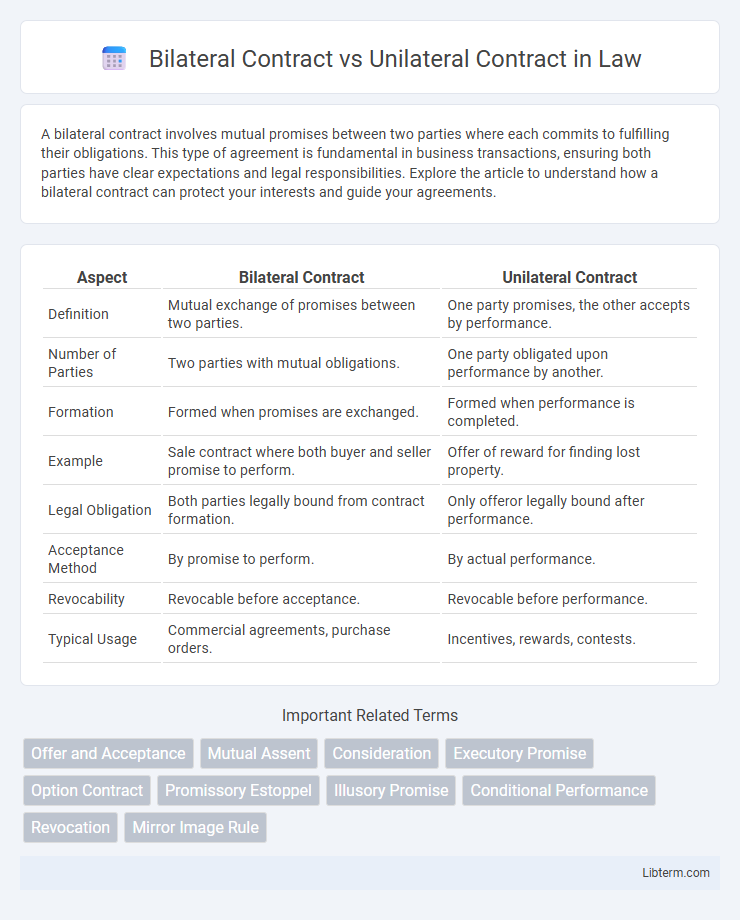A bilateral contract involves mutual promises between two parties where each commits to fulfilling their obligations. This type of agreement is fundamental in business transactions, ensuring both parties have clear expectations and legal responsibilities. Explore the article to understand how a bilateral contract can protect your interests and guide your agreements.
Table of Comparison
| Aspect | Bilateral Contract | Unilateral Contract |
|---|---|---|
| Definition | Mutual exchange of promises between two parties. | One party promises, the other accepts by performance. |
| Number of Parties | Two parties with mutual obligations. | One party obligated upon performance by another. |
| Formation | Formed when promises are exchanged. | Formed when performance is completed. |
| Example | Sale contract where both buyer and seller promise to perform. | Offer of reward for finding lost property. |
| Legal Obligation | Both parties legally bound from contract formation. | Only offeror legally bound after performance. |
| Acceptance Method | By promise to perform. | By actual performance. |
| Revocability | Revocable before acceptance. | Revocable before performance. |
| Typical Usage | Commercial agreements, purchase orders. | Incentives, rewards, contests. |
Understanding Bilateral and Unilateral Contracts
Bilateral contracts involve mutual promises between two parties, where each party commits to fulfilling their obligation, creating a binding agreement upon exchange of promises. Unilateral contracts consist of a promise made by one party in exchange for the performance of an act by another party, binding only when the act is completed. Understanding the distinction is crucial for determining contractual obligations, enforceability, and remedies in contract law.
Key Definitions: Bilateral vs Unilateral Contracts
A bilateral contract involves a mutual exchange of promises where both parties commit to performing specific obligations, creating reciprocal legal duties. In contrast, a unilateral contract features a promise made by one party in exchange for the performance of an act by another, with the contract only formed upon completion of that act. Key distinctions hinge on the number of parties making promises and the timing of contract formation, with bilateral contracts binding both parties immediately and unilateral contracts obligating the promisor only after the requested action is performed.
Essential Elements of Bilateral Contracts
Bilateral contracts require mutual promises between two parties where each party is both a promisor and a promisee, emphasizing offer, acceptance, consideration, and mutual intention to create legal relations. Essential elements include a clear offer by one party and an unequivocal acceptance by the other, establishing a binding agreement enforceable by law. Consideration must be exchanged, reflecting the value each party agrees to provide, while both parties demonstrate their consent, ensuring the contract's validity.
Core Components of Unilateral Contracts
Unilateral contracts are characterized by a promise in exchange for performance, requiring one party to fulfill an act rather than make a reciprocal promise. Core components include a clear offer that invites performance, acceptance only by completing the specified act, and the obligation arising when the requested act is performed. Unlike bilateral contracts, unilateral contracts do not require mutual promises but hinge on one party's completed action triggering the contract's binding effect.
How Bilateral Contracts Work in Practice
Bilateral contracts involve mutual promises where both parties commit to performing certain obligations, creating binding agreements enforceable by law. In practice, each party acts as both promisor and promisee, exchanging consideration such as payment for services or goods, which ensures reciprocal duties. This mutual exchange facilitates clear expectations and legal remedies if either party fails to fulfill their contractual obligations.
Real-World Examples of Unilateral Contracts
A unilateral contract is exemplified in real-world scenarios such as reward offers, where one party promises payment upon completion of a specified act, like returning a lost pet or delivering an item. Another common example is insurance policies, where the insurer commits to pay benefits only after the insured event occurs, emphasizing the one-sided promise contingent on performance by the other party. These contrasts with bilateral contracts, where mutual promises are exchanged upfront, such as in sales agreements or employment contracts.
Major Differences Between Bilateral and Unilateral Contracts
Bilateral contracts involve mutual promises where both parties commit to perform obligations, creating a binding agreement upon exchange of promises. Unilateral contracts require only one party to make a promise, with the contract formed once the other party completes the specified act. The major differences include the number of parties making promises and the point at which the contract becomes binding, with bilateral contracts binding at promise exchange and unilateral contracts at performance completion.
Legal Implications: Bilateral vs Unilateral Agreements
Bilateral contracts, involving mutual promises between parties, create enforceable obligations on both sides, ensuring legal recourse if either party defaults. Unilateral contracts, offering a promise in exchange for an act, bind the offeror only upon complete performance by the offeree, limiting liability until the act is fulfilled. Courts typically interpret bilateral agreements as mutual commitments, while unilateral contracts require strict adherence to performance conditions to establish legal rights.
Advantages and Disadvantages of Each Contract Type
Bilateral contracts offer clear mutual obligations, enhancing predictability and enforceability for both parties, but may involve longer negotiation and exposure to breach risks. Unilateral contracts simplify performance by binding only one party initially, reducing upfront commitment, yet they can result in uncertainty for the promisor due to reliance on the other party's action. Choosing between bilateral and unilateral contracts depends on the desired balance between mutual obligation certainty and flexibility in contract formation.
Choosing the Right Contract for Your Needs
Bilateral contracts involve mutual promises where both parties are obligated to perform, making them ideal for transactions requiring clear reciprocal commitments. Unilateral contracts bind only one party, typically used for reward-based or performance-specific agreements where the other party's action triggers the obligation. Choosing the right contract depends on whether you need enforceable mutual obligations or flexible, action-driven commitments tailored to risk and assurance preferences.
Bilateral Contract Infographic

 libterm.com
libterm.com